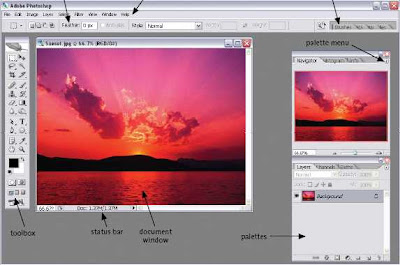
options.bar palette.well
palettes toolbox status.bar document
window
The.Photoshop.workspace
You can customize your Photoshop workspace to suit you or your project—almost
everything within your workspace can be repositioned and reconfigured! You might
choose to customize your workspace by:
changing the look of the menu bar
You can change which menu items are visible in your menu bar, and even add
color to your menu items. If you wanted, you could also assign new or different
keyboard shortcuts to menu commands (which I don’t recommend until you feel
very comfortable with Photoshop or have a compelling reason to do so!). Go to
Edit > Menus and use the dialog box to modify the menu bar and palette menus.
moving the options bar
If you want to move the options bar, you can do so by clicking on the handle
on its left side and moving it around. The options bar will “dock” to the top or
bottom of the screen automatically if moved near those areas.
Getting Started with Photoshop
The Photoshop Anthology moving the toolbox
The toolbox is extremely portable, and can be moved to any location on your
screen. Move the toolbox by clicking on the gray area at the top of it and dragging
it around.
rearranging palettes
There are many ways to rearrange your palettes. You might want to separate a
palette from its palette group, and move it into another group. You can do this
by dragging the palette tab out of its original group and into the new group. You
might also decide to drag some of your palette tabs into the palette well, and
close the rest. To display a palette that has been closed, go to Window and select
the palette you want to show.
displaying different information in the
document window status bar
The status bar displays the document
file size by default. The file size is
shown as two numbers separated by
a forward slash: the first number is
an approximation of the image file
size with all layers merged (known as
“flattening” the image), and the second
number is an approximation of the
total file size of the image with layers
intact. If all this sounds new to you,
don’t worry—we’ll be discussing layers
shortly. You can set the status bar to
display different information, such as
the document dimension in pixels, or
the version number of the file. To do
this, click on the arrow icon next to the
status bar, select Show and choose the
information you’d like to see.
Changing.the.status.bar
Saving your Customized Workspace
As you become more proficient with Photoshop, you may discover that you use
certain sets of palettes for different types of projects, and that there are some
palettes that you don’t use at all. Photoshop allows you to save and load different
workspaces—different arrangements of palettes, menus, and even different keyboardworkspaces—different arrangements of palettes, menus, and even different keyboard
shortcuts—to help you work more efficiently.
After you’ve customized your workspace to your satisfaction, select Window >
Workspace > Save Workspace from the menu bar and enter a name for your workspace,
such as Creating Thumbnails or My Default Workspace. You can then load your different
workspaces by opening Window > Workspace and selecting your custom workspace
shortcuts—to help you work more efficiently.
After you’ve customized your workspace to your satisfaction, select Window >
Workspace > Save Workspace from the menu bar and enter a name for your workspace,
such as Creating Thumbnails or My Default Workspace. You can then load your different
workspaces by opening Window > Workspace and selecting your custom workspace







0 comments:
Post a Comment